Management of Slum-Based Urban Farming and Economic Empowerment of the Community of Makassar City, South Sulawesi, Indonesia
Abstract
1. Introduction
2. Conceptual Framework
2.1. Urban Farming Based on Community Economic Empowerment
2.2. Economic Business Sustainability and Community Independence
3. Materials and Methods
3.1. Research Design
3.2. Study Area
3.3. Data Collection Method
3.3.1. Observation
3.3.2. In-Depth Interviews
3.3.3. Questionnaire
3.3.4. Documentation
3.3.5. Triangulation
- To answer research questions, what influence do business motivation, human resource capacity, community participation, and economic business management have on urban farming-based economic empowerment in the handling of slum settlements in the Metro Tanjung Bunga area of Makassar City? The parameters used as a reference include: (a) business motivation is measured based on the encouragement and willingness of the community, in the sense that strong or weak community motivation plays a role in determining the size of the achievements achieved. Indicators that are used as a reference, namely the driving force, willingness, forming expertise, forming skills, responsibilities and obligations; (b) the capacity of human resources is measured based on the capacity of the community and the role of the institution as a system to carry out its functions or authority to achieve goals effectively and efficiently. Indicators used as a reference, namely competence, education, training, and experience; (c) community participation is measured based on the participation of individuals and community groups to support the implementation and success of urban farming. Indicators used as a reference, namely participation in decision making, participation in the implementation of activities, participation in monitoring, and participation in the utilization of results; (d) economic business management is measured based on the community’s ability to manage an urban farming-based economic business. Indicators that are used as references, namely the type of business, productivity, financial administration management, and business legality; (e) community economic empowerment is measured based on community welfare and the innovations that can be created. Indicators used as a reference, namely the level of income, skills to manage the business, and the stability of the marketing of the products; (f) management of slum settlements is measured based on basic infrastructure services for settlements, community economic conditions, and socio-cultural conditions. The indicators used as a reference are the fulfillment of basic infrastructure services, economic access, and social cohesion.
- To answer research questions, what are the direct and indirect relationships of urban farming, community capacity, and business capital support for improving the welfare and independence of the community in the Metro Tanjung Bunga area of Makassar City? The parameters used as a reference include: (a) urban farming is measured based on the success of its implementation based on the value of benefits received by the community. Indicators that are measured to assess the implementation of urban farming, namely socialization, activity planning, and activity implementation; (b) community capacity is measured based on adaptability, readiness, and involvement. Indicators that are used as references, namely adaptive response, motivation to attend training, and ability to build a business; (c) business capital support is measured based on the ability to utilize capital, business capital support from the government, and access to finance; (d) community welfare is measured based on the level of income, the ability to meet basic needs, and the ability to pay for the socio-economic needs of the family, namely the ability to build adequate housing facilities, the cost of children’s education, and health services. (e) community independence is measured based on awareness and desire to change, ability to increase capacity to gain access, ability to face obstacles, and ability to build cooperation and solidarity. The indicators used as references are community-based development, economic sustainability, community participation, development of social capital, and elimination of socio-economic inequality.
- To answer the research question, what is the sustainability model for handling slums in the Metro Tanjung Bunga area of Makassar City? The parameters used as a reference, namely (i) infrastructure aspects are measured based on the feasibility of community residential buildings and green open space preparation, (ii) economic activities are measured based on business development and business capital assistance, and (iii) social problem solving is measured based on community participation in settlement of social conflicts and handling slum settlements through optimizing the use of social capital that has been built. Environmental pollution control is carried out through support for changes in attitudes and behavior of the community. The success performance of handling slum settlements is measured based on two things, namely (i) increasing the economic productivity of the community, and (ii) improving the quality of the environment. Furthermore, the sustainability of slum settlement is measured based on three things, namely (i) economic sustainability, (ii) social sustainability, and (iii) community independence.
3.4. Research Informants and Respondents
3.5. Data Analysis Method
4. Results
4.1. Poverty and Community Marginalization
4.2. The Characteristics and Typology of Slum Settlements
4.3. The Socio-Economic Characteristics of Local Communities
4.4. The Implementation of Community-Based Urban Farming Concepts
4.5. Economic Sustainability and Community Independence
5. Discussion
5.1. Urban Farming-Based Slum Settlement Solutions
5.2. Sustainability of Community-Based Slum Settlements
6. Conclusions
Author Contributions
Funding
Acknowledgments
Conflicts of Interest
References
- Yang, Z.; Lei, J.; Gang Li, J. Identifying the determinants of urbanization in prefecture-level cities in China: A quantitative analysis based on spatial production theory. Sustainability 2019, 11, 1204. [Google Scholar] [CrossRef]
- Kostecki, J.; Greinert, A. Influence of technic surfaces on the selected properties of ekranic technosols. In Urbanization: Challenge and Opportunity for Soil Functions and Ecosystem Services; Springer International Publishing: New York, NY, USA, 2019; pp. 21–30. [Google Scholar] [CrossRef]
- Seto, K.C.; Rodríguez, R.S.; Fragkias, M. The new geography of contemporary urbanization and the environment. Annu. Rev. Environ. Resour. 2010, 35, 167–194. [Google Scholar] [CrossRef]
- Surya, B. The processes analysis of urbanization, spatial articulation, social change and social capital difference in the dynamics of new town development in the fringe area of Makassar City (case study: In metro Tanjung Bunga Area, Makassar City). Procedia Soc. Behav. Sci. 2016, 227, 216–231. [Google Scholar] [CrossRef][Green Version]
- Rahayu, P.; Mardiansjah, F.H. Characteristics of peri-urbanization of a secondary city: A challenge in recent urban development. IOP Conf. Ser. Earth Environ. Sci. 2018, 126, 012164. [Google Scholar] [CrossRef]
- Work Bank Report. The Changing Nature of Work. 2019. Available online: https://www.worldbank.org/en/publication/wdr2019 (accessed on 5 February 2020).
- Surya, B. The dynamics of spatial structure and spatial pattern changes at the fringe area of Makassar City. Indones. J. Geograph. 2015, 47, 11–19. [Google Scholar] [CrossRef]
- Jones, P. Formalizing the informal: Understanding the position of informal settlements and slums in sustainable urbanization policies and strategies in Bandung, Indonesia. Sustainability 2017, 9, 1436. [Google Scholar] [CrossRef]
- Surya, B.; Ahmad, D.N.A.; Sakti, H.H.; Sahban, H. Land use change, spatial interaction, and sustainable development in the metropolitan urban areas, South Sulawesi Province, Indonesia. Land 2020, 9, 95. [Google Scholar] [CrossRef]
- Wilonoyudho, S.; Rijanta, R.; Keban, Y.T.; Setiawan, B. Urbanization and regional imbalances in Indonesia. Indones. J. Geograph. 2017, 49, 125–132. [Google Scholar] [CrossRef]
- Surya, B.; Saleh, H.; Remmang, H. Economic gentrification and socio-cultural transformation metropolitan suburban of Mamminasata. J. Eng. Appl. Sci. 2018, 13, 6072–6084. [Google Scholar] [CrossRef]
- Surya, B. Spatial interaction pattern and the process of city activity formation system (case study, Ternate City, Tidore Archipelago City and Sofifi City of North Maluku, Indonesia). Res. J. Appl. Sci. 2015, 10, 880–892. [Google Scholar]
- Gross, M. The urbanisation of our species. Curr. Biol. 2016, 26, 1205–1208. [Google Scholar] [CrossRef] [PubMed]
- Surya, B. Rationalization of community actions, public spaces privatization and urban informal sector economic behavior (a case: Hertasning road corridor of Makassar City). Middle East J. Sci. Res. 2015, 23, 2219–2231. [Google Scholar] [CrossRef]
- Fan, P.; Yue, W.; Zhang, J.; Huang, H.; Messina, J.; Verburg, P.H.; Qi, J.; Moore, N.; Ge, J. The spatial restructuring and determinants of industrial landscape in a mega city under rapid urbanization. Habitat Int. 2020, 95, 1–14. [Google Scholar] [CrossRef]
- Surya, B. Globalization, modernization, mastery of reproduction of space, spatial articulation and social change in developmental dynamics in suburb area of Makassar City (a study concerning on urban spatial sociology). Asian Soc. Sci. 2014, 10, 261–268. [Google Scholar] [CrossRef][Green Version]
- Dauglass, I. The challenge of urban poverty for the use of green infrastructure on floodplains and wetlands to reduce flood impacts in intertropical Africa. Landsc. Urban Plan. 2018, 180, 267–272. [Google Scholar] [CrossRef]
- Zandi, R.; Zanganeh, M.; Akbari, E. Zoning and spatial analysis of poverty in urban areas (case study: Sabzevar City-Iran). J. Urban. Manag. 2019, 8, 342–354. [Google Scholar] [CrossRef]
- Bappenas Report. Rencana Pembangunan Jangka Menengah Nasional (RPJMN) 2015–2019. 2015. Available online: https://www.bappenas.go.id/id/data-dan-informasi-utama/dokumen-perencanaan-dan-pelaksanaan/dokumen-rencana-pembangunan-nasional/rpjp-2005-2025/rpjmn-2015-2019/ (accessed on 20 January 2020).
- Udin, N. Assessing urban sustainability of slum settlements in Bangladesh: Evidence from Chittagong City. J. Urban Manag. 2018, 7, 32–42. [Google Scholar] [CrossRef]
- UN-Habitat. UN-Habitat the Challenge of Slums; Earthscan: London, UK, 2003; Available online: https://www.un.org/ruleoflaw/files/Challenge%20of%20Slums.pdf (accessed on 25 January 2020).
- Almeida, T. Neoliberal Policy and the Growth of Slums. Prospect Journal of International Affairs at UCSD, 2012. Available online: https://prospectjournal.org/2012/05/21/neoliberal-policy-and-the-growth-of-slums (accessed on 25 January 2020).
- Shi, P.J.; Chen, L.; Liu, H.L.; Liu, H.M. Evaluation of urbanization coordination degrees in Gansu province. Appl. Mech. Mater. 2013, 295–298, 2486–2492. [Google Scholar] [CrossRef]
- Xie, H.; Zhang, Y.; Duan, K. Evolutionary overview of urban expansion based on bibliometric analysis in Web of Science from 1990 to 2019. Habitat Int. 2020, 95, 1–23. [Google Scholar] [CrossRef]
- Meredith, T.; MacDonald, M. Community-supported slum-upgrading: Innovations from Kibera, Nairobi, Kenya. Habitat Int. 2017, 60, 1–9. [Google Scholar] [CrossRef]
- Joshi, A. Legal empowerment and social accountability: Complementary strategies toward rights-based development in health? World Dev. 2017, 99, 160–172. [Google Scholar] [CrossRef]
- Pedro, A.A.; Queiroz, A.P. Slum: Comparing municipal and census basemaps. Habitat Int. 2019, 83, 30–40. [Google Scholar] [CrossRef]
- Taubenböck, H. Ohne limit? Die expansion von megacities. In Globale Urbanisierung-Perspektive aus dem All; Taubenböck, H., Wurm, M., Esch, T., Dech, S., Eds.; Springer: Berlin/Heidelberg, Germany, 2015; pp. 49–58. Available online: https://www.springer.com/de/book/9783662448403 (accessed on 30 January 2020).
- Surya, B.; Syafri, S.; Sahban, H.; Sakti, H.H. Natural resource conservation based on community economic empowerment: Perspectives on watershed management and slum settlements in Makassar City, South Sulawesi, Indonesia. Land 2020, 9, 104. [Google Scholar] [CrossRef]
- BPS Makassar City. Makassar City in Figures. 2019. Available online: https://makassarkota.bps.go.id/publication/2019/08/16/4ca03301b8e2b8414e33f6a3/kota-makassar-dalam-angka-2019.html (accessed on 3 February 2020).
- Niva, V.; Taka, M.; Varis, O. Rural-urban migration and the growth of informal settlements: A socio-ecological system conceptualization with insights through a “water lens”. Sustainability 2019, 11, 3487. [Google Scholar] [CrossRef]
- Liddle, B. Urbanization, and Inequality/Poverty. Urban. Sci. 2017, 1, 35. [Google Scholar] [CrossRef]
- Surya, B.; Saleh, H.; Abubakar, H. Sustainability of slum-based settlement management community socio-economic empowerment (study on slum settlements in Panakkukang District, Makassar City). J. Eng. Appl. Sci. 2020, 15, 141–152. [Google Scholar] [CrossRef]
- Nicli, S.; Elsen, S.U.; Bernhard, A. Eco-social agriculture for social transformation and environmental sustainability: A case study of the UPAS-project. Sustainability 2020, 12, 5510. [Google Scholar] [CrossRef]
- Andriani, D.N.; Wibawa, R.P.; Wihartanti, L.V. Selection of poverty reduction program through community-based economic empowerment in Madiun City. Indones. J. Plan. Dev. 2019, 4, 7–13. [Google Scholar] [CrossRef]
- Chin, E.Y.; Kupfer, J.A. Identification of environmental drivers in urban greenway communities. Urban. For. Urban. Green. 2020, 47, 1–11. [Google Scholar] [CrossRef]
- Rezai, G.; Shamsudin, M.N.; Mohamed, Z.A. Urban agriculture: A way forward to food and nutrition security in Malaysia. Procedia Soc. Behav. Sci. 2016, 216, 39–45. [Google Scholar] [CrossRef]
- Al-Kodmany, K. The vertical farm: A review of developments and implications for the Vertical City. Buildings 2018, 8, 24. [Google Scholar] [CrossRef]
- Ann Diehl, J. Growing for Sydney: Exploring the urban food system through farmers’ social networks. Sustainability 2020, 12, 3346. [Google Scholar] [CrossRef]
- Artmann, M.; Sartison, K. The role of urban agriculture as a nature-based solution: A review for developing a systemic assessment framework. Sustainability 2018, 10, 1937. [Google Scholar] [CrossRef]
- Grewal, S.S.; Grewal, P.S. Can cities become self-reliant in food? Cities 2012, 29, 1–11. [Google Scholar] [CrossRef]
- Haberman, D.; Gillies, L.; Canter, A.; Rinner, V.; Pancrazi, L.; Martellozzo, F. The potential of urban agriculture in Montréal: A quantitative assessment. Int. J. Geo-Inf. 2014, 3, 1101–1117. [Google Scholar] [CrossRef]
- Akhter, J.; Cheng, K. Sustainable empowerment initiatives among rural women through microcredit borrowings in Bangladesh. Sustainability 2020, 12, 2275. [Google Scholar] [CrossRef]
- Soetomo. Kesejahteraan dan Upaya Mewujudkannya dalam Prespektif Masayarakat Lokal, Yogyakarta: Pustaka Belajar. 2014. Available online: https://catalogue.nla.gov.au/Record/6574977 (accessed on 5 May 2020).
- Suharto, E. Membangun Masyarakat Memberdayakan Rakyat, Bandung. Refika Aditama. 2005. Available online: https://adoc.tips/suharto-edi-membangun-masyarakat-memberdayakan-rakyat-refika.html (accessed on 25 May 2020).
- Mardikanto, T.; dan Poerwoko, S. Pemberdayaan Masyarakat dalam Perspektif Kebijakan Publik. Bandung: CV Alfabeta. 2012. Available online: https://cvalfabeta.com/product/pemberdayaan-masyarakat-dalam-perspektif-kebijakan-publik/ (accessed on 2 June 2020).
- Sugiyono. Metode Penelitian Kuantitatif, Kualitatif dan R&D. Bandung: PT Alfabet. 2016. Available online: http://cvalfabeta.com/product/metode-penelitian-kuantitatif-kualitatif-dan-rd-mpkk/ (accessed on 2 April 2020).
- Sudjana, N.; dan Rivai, A. Media Pengajaran. Bandung: Sinar Baru Algesindo. 2019. Available online: https://shopee.co.id/media-pengajaran-nana-sudjana-Ahmad-Rivai-Sinar-Baru-Algesindo-i.31017398.1365481033 (accessed on 12 April 2020).
- Arikunto, S. Dasar—Dasar Evaluasi Pendidikan. Jakarta: Bumi Aksara. 2013. Available online: https://adoc.tips/arikunto-s-2013-dasar-dasar-evaluasi-pendidikan-jakarta-bumi.html (accessed on 4 April 2020).
- Lombard, M. Constructing ordinary places: Place-making in urban informal settlements in Mexico. Prog. Plan. 2014, 94, 1–53. [Google Scholar] [CrossRef]
- Musterd, S.; van Gent, W.P.C.; Das, M.; Latten, J. Adaptive behaviour in urban space: Residential mobility in response to social distance. Urban Stud. 2014, 53, 227–246. [Google Scholar] [CrossRef]
- Sadorsky, P. The effect of urbanization and industrialization on energy use in emerging economies: Implications for sustainable development. Am. J. Econ. Soc. 2014, 73, 392–409. [Google Scholar] [CrossRef]
- Surya, B. Change phenomena of spatial physical in the dynamics of development in urban fringe area. Indones. J. Geograph. 2016, 48, 118–134. [Google Scholar] [CrossRef]
- Peng, J.; Tian, L.; Liu, Y.; Zhao, M.; Hu, Y.; Wu, J. Ecosystem services response to urbanization in metropolitan areas: Thresholds identification. Sci. Total Environ. 2017, 607–608, 706–714. [Google Scholar] [CrossRef] [PubMed]
- Wang, H.; Qin, J.; Zhao, B.; Chen, J.; Dong, L.; Hu, Y. Spatio temporal dynamics of plant diversity in response to farmers’ evolved settlements in Shanghai. Urban For. Urban Green. 2017, 22, 64–73. [Google Scholar] [CrossRef]
- Surya, B. Optimization of function and role of traditional markets in urban development system of Ketapang City (a case study: Range Sentap Market, Delta Pawan Subdistrict, Ketapang City). World Appl. Sci. J. 2015, 33, 1457–1471. [Google Scholar] [CrossRef]
- Denzin, N.K.; Lincoln, Y.S. HandBook of Qualitative Research. Penerbit. Pustaka Pelajar. 2009. Available online: http://pustakapelajar.co.id/buku/handbook-of-qualitative-research/ (accessed on 3 March 2020).
- Creswell, J.W. Pendekatan Kualitatif, Kuantitatif, dan Mixed. Penerbit. Pustaka Pelajar. 2015. Available online: http://pustakapelajar.co.id/buku/research-design-pendekatan-kualitatif-kuantitatif-dan-mixed/ (accessed on 3 March 2020).
- Arikunto, S. Prosedur Penelitian Suatu Pendekatan Praktek; PT. Rineka Cipta: Jakarta, Indonesia, 2006. [Google Scholar]
- Notoatmodjo, S. Metodologi Penelitian Kesehatan; PT. Rineka Cipta: Jakarta, Indonesia, 2010. [Google Scholar]
- Cochran, W.G. Sampling Technique, 3rd ed.; John Wiley and Sons: New York, NY, USA, 1977; p. 422. Available online: https://www.wiley.com/en-us/Sampling+Techniques%2C+3rd+Edition-p-9780471162407 (accessed on 12 March 2020).
- Irwanto. Focused Group Discussion (FGD): Sebuah Pengantar Praktis. Jakarta: Yayasan Obor Indonesia. 2006. Available online: http://obor.or.id/Focused-Group-Discussion (accessed on 20 March 2020).
- Ferdinand. Metode Penelitian Manajemen: Pedoman penelitian untuk Skripsi, Tesis, dan Desertasi Ilmu Manajemen, Semarang: Badan Penerbit Universitas Diponegoro. 2002. Available online: http://fia.ub.ac.id/katalog/index.php?p=show_detail&id=7986&keywords= (accessed on 22 March 2020).
- Samuelsson, K.; Giusti, M.; Peterson, G.D.; Legeby, A.; Brandt, S.A.; Barthel, S. Impact of environment on people’s everyday experiences in Stockholm. Lansc. Urban Plan. 2018, 171, 7–17. [Google Scholar] [CrossRef]
- Nahui, Z.; Bojie, F.U.; Yihe, L.U.; Shuai, W. Poverty reduction, environmental protection and ecosystem services: A prospective theory for sustainable development. Chin. Geogr. Sci. 2014, 24, 83–92. [Google Scholar] [CrossRef]
- Dengsheng, L.; Weng, Q. Use of impervious surface in urban land-use classification. Remote Sens. Environ. 2006, 102, 146–160. [Google Scholar] [CrossRef]
- Ma, Q.; Wu, J.; He, C.; Hu, G. Spatial scaling of urban impervious surfaces across evolving landscapes: From cities to urban regions. Landsc. Urban Plan. 2018, 175, 50–61. [Google Scholar] [CrossRef]
- Surya, B. Social change, spatial articulation in the dynamics of boomtown construction and development (case satudy of metro Tanjung Bunga Boomtown, Makassar). Mod. Appl. Sci. 2014, 8, 238–245. [Google Scholar] [CrossRef][Green Version]
- Lorilla, R.S.; Poirazidis, K.; Kalogirou, S.; Detsis, V.; Martinis, A. Assessment of the spatial dynamics and interactions among multiple ecosystem services to promote effective policy making across Mediterranean island landscapes. Sustainability 2018, 10, 3285. [Google Scholar] [CrossRef]
- Gomes, E. Sustainable population growth in low-density areas in a new technological era: Prospective thinking on how to support planning policies using complex spatial models. Land 2020, 9, 221. [Google Scholar] [CrossRef]
- Hornung, S. Crafting task and cognitive job boundaries to enhance self-determination, impact, meaning and competence at work. Behav. Sci. 2019, 9, 136. [Google Scholar] [CrossRef]
- Hui, F.K.P.; Aye, L. Occupational stress and workplace design. Buildings 2018, 8, 133. [Google Scholar] [CrossRef]
- Nassar, D.M.; Elsayed, H.G. From Informal Settlements to sustainable communities. Alexandria Eng. J. 2018, 57, 2367–2376. [Google Scholar] [CrossRef]
- Albertí, J.; Roca, M.; Brodhag, C.; Fullana-i-Palmer, P. Allocation and system boundary in life cycle assessments of cities. Habitat Int. 2019, 83, 41–54. [Google Scholar] [CrossRef]
- Salvia, R.; Kelly, C.L.; Wilson, G.A.; Quaranta, G. A longitudinal approach to examining the socio-economic resilience of the Alento District (Italy) to land degradation—1950 to Present. Sustainability 2019, 11, 6762. [Google Scholar] [CrossRef]
- Pitarch-Garrido, M.D. Social sustainability in metropolitan areas: Accessibility and equity in the case of the metropolitan area of Valencia (Spain). Sustainability 2018, 10, 371. [Google Scholar] [CrossRef]
- Al-Qahtani, M.M.Z.; Alkhateeb, T.T.Y.; Mahmood, H.; Zahed Abdalla, M.A.; Talalah Qaralleh, T.J.O. The role of the academic and political empowerment of women in economic, social, and managerial empowerment: The case of Saudi Arabia. Economies 2020, 8, 45. [Google Scholar] [CrossRef]
- Visvizi, A.; Lytras, M.D.; Pachocka, M. Multiple facets of migration research: Key questions, topics, and avenues yet to be explored. Sustainability 2020, 12, 225. [Google Scholar] [CrossRef]
- Cockburn, J.; Rosenberg, E.; Copteros, A.; Cornelius, S.F.; Libala, N.; Metcalfe, L.; van der Waal, B. A relational approach to landscape stewardship: Towards a new perspective for multi-actor collaboration. Land 2020, 9, 224. [Google Scholar] [CrossRef]
- Surya, B.; Ruslan, M.; Abubakar, H. Inequility of space reproduction control and urban slum area management sustainability (case study: Slum area of Buloa Urban Village in Makassar City). J. Eng. Appl. Sci. 2018, 13, 6033–6042. [Google Scholar]
- Wu, F. Urban poverty and marginalization under market transition: The case of Chinese cities. Int. J. Urban Reg. Res. 2004, 28, 401–423. [Google Scholar] [CrossRef]
- Chimankar, D.A. Urbanization and condition of urban slums in India. Indones. J. Geogr. 2016, 48, 28–36. [Google Scholar] [CrossRef]
- Ye, C.; Chen, M.; Chenet, R. Multi-scalar separations: Land use and production of space in Xianlin, a university town in Nanjing, China. Habitat Int. 2014, 42, 264–272. [Google Scholar] [CrossRef]
- Surya, B.; Saleh, H.; Ariyanto, A. Transformation of metropolitan suburban area (a study on new town development in Moncongloe-Pattalassang Metropolitan Maminasata). IOP Conf. Ser. Earth Environ. Sci. 2018, 202, 1–10. [Google Scholar] [CrossRef]
- Mahabir, R.; Agouris, P.; Stefanidis, A.; Croitoru, A.; Crooks, A.T. The study of slums as social and physical constructs: Challenges and emerging research opportunities. Reg. Stud. Reg. Sci. 2016, 3, 399–419. [Google Scholar] [CrossRef]
- Gilbert, A. Ten myths undermining Latin American housing policy. Revista de Ingeniería 2011, 35, 79–87. Available online: http://www.scielo.org.co/pdf/ring/n35/n35a13.pdf (accessed on 3 February 2020).
- Richter, C.; Miscione, G.; De, R.; Pfeffer, K. Enlisting SDI for urban planning in India: Local practices in the case of slum declaration. In Spatial Data Infrastructures in Context; Georgiadou, Y., Crompvoets, J., Georgiadou, Y., Eds.; CRC Press: Boca Raton, FL, USA, 2011; pp. 157–179. Available online: https://hdl.handle.net/11245/1.353315 (accessed on 3 February 2020).
- Hussain, T.; Abbas, J.; Wei, Z.; Nurunnabi, M. The effect of sustainable urban planning and slum disamenity on the value of neighboring residential property: Application of the hedonic pricing model in rent price appraisal. Sustainability 2019, 11, 1144. [Google Scholar] [CrossRef]
- Diao, B.; Ding, L.; Zhang, Q.; Na, J.; Cheng, J. Impact of urbanization on PM2.5-related health and economic loss in China 338 cities. Int. J. Environ. Res. Public Health 2020, 17, 990. [Google Scholar] [CrossRef]
- Khalifa, M.A. Evolution of informal settlements upgrading strategies in Egypt: From negligence to participatory development. Ain Shams Eng. J. 2015, 6, 1151–1159. [Google Scholar] [CrossRef]
- Wang, X.; Tomaney, J. Zhengzhou-political economy of an emerging Chinese megacity. Cities 2019, 84, 104–111. [Google Scholar] [CrossRef]
- Sheng, M.; Gu, C. Economic growth and development in Macau (1999–2016): The role of the booming gaming industry. Cities 2018, 75, 72–80. [Google Scholar] [CrossRef]
- Ghani, Z.A. A comparative study of urban crime between Malaysia and Nigeria. J. Urban Manag. 2017, 6, 19–29. [Google Scholar] [CrossRef]
- Roy, D.; Lees, M.H.; Palavalli, B.; Pfeffer, K.; Peter Sloot, M.A. The emergence of slums: A contemporary view on simulation models. Environ. Model. Softw. 2014, 59, 76–90. [Google Scholar] [CrossRef]
- Wang, Y.; Liu, K. Evolution of urban socio-spatial structure in modern times in Xi’an, China. Sustainability 2017, 9, 1935. [Google Scholar] [CrossRef]
- Medda, F. Land value capture finance for transport accessibility: A review. J. Transp. Geogr. 2012, 25, 154–161. [Google Scholar] [CrossRef]
- Manganelli, B.; Murgante, B. The dynamics of urban land rent in italian regional capital cities. Land 2017, 6, 54. [Google Scholar] [CrossRef]
- Utami, S.; Soemarno; Surjono; Bisri, M. Disaster riskand adaptation of settlement alongthe river brantasin the context of sustainable development, Malang, Indonesia. Procedia Soc. Behav. Sci. 2014, 20, 602–611. [Google Scholar] [CrossRef][Green Version]
- Patel, A.; Koizumi, N.; Crooks, A. Measuring slum severity in Mumbai and Kolkata: A household-based approach. Habitat Int. 2014, 41, 300–306. [Google Scholar] [CrossRef]
- Takeuchi, A.; Cropper, M.; Bento, A. Measuring the welfare effects of slum improvement programs: The case of Mumbai. J. Urban Econ. 2008, 64, 65–84. [Google Scholar] [CrossRef]
- Rudito, B. The improvement of community economy as impact of corporate social responsibility program: A case study in Pengalengan, Bandung, West Java, Indonesia. Procedia Soc. Behav. Sci. 2014, 164, 471–476. [Google Scholar] [CrossRef][Green Version]
- Ababio, M.O.; Grant, R. Ideological traces in Ghana’s urban plans: How do traces get worked out in the Agbogbloshie, Accra? Habitat Int. 2019, 83, 1–10. [Google Scholar] [CrossRef]
- Kristóf, A. The impact of suburbanization on social differentiation in Hungary: A case study of the miskolc agglomeration. Geogr. Pannonica 2018, 22, 176–188. [Google Scholar] [CrossRef]
- Wang, Y.-c.; Shen, J.-k.; Xiang, W.-n.; Wang, J.Q. Identifying characteristics of resilient urban communities through a case study method. J. Urban. Manag. 2018, 7, 141–151. [Google Scholar] [CrossRef]
- Martadwiprani, H.; Rahmawati, D. Economic development as community resilience enhancement in minapolis coastal settlement. Procedia Soc. Behav. Sci. 2014, 35, 106–111. [Google Scholar] [CrossRef][Green Version]
- Surya, B. Spatial articulation and co-existence of mode of production in the dynamics of development at the urban fringe of Makassar City. J. Eng. Appl. Sci. 2015, 10, 214–222. [Google Scholar]
- Jaitman, L.; Brakarz, J. Evaluation of Slum Upgrading Programs. Literature Review and Methodological Approaches. 2013. Available online: https://publications.iadb.org/en/publication/11896/evaluation-slum-upgrading-programs-literature-review-and-methodological (accessed on 5 February 2020).
- Surya, B.; Syafri, S.; Abubakar, H.; Sahban, H.; Sakti, H.H. Spatial Transformation of new city area: Economic, social, and environmental sustainability perspective of Makassar City, Indonesia. J. Southwest Jiaotong Univ. 2020, 55, 1–29. [Google Scholar]
- Olajide, O.A.; Agunbiade, M.E.; Bishi, H.B. The realities of Lagos urban development vision on livelihoods of the urban poor. J. Urban. Manag. 2018, 7, 21–31. [Google Scholar] [CrossRef]
- Pujo, P.; Sofhani, T.F.; Gunawan, B.; Syamsudin, T.S. Community capacity building in social forestry development: A review. J. Reg. City Plan. 2018, 29, 113–126. [Google Scholar] [CrossRef]
- World Bank Report. Indonesia National Urban Slum Upgrading Program. Project Information Document (PID) Concept Stage. 2016, pp. 1–8. Available online: http://documents.worldbank.org/curated/en/578691468262777781/pdf/PID-Print-P154782-12-10-2015-1449744758134.pdf (accessed on 6 February 2020).
- Zhang, S. Land-centered urban politics in transitional China—Can they be explained by Growth Machine Theory? Cities 2014, 41, 179–186. [Google Scholar] [CrossRef]
- Rostin. The Effect of Economic Empowerment of the Coastal Communities and Social Capital on Coastal Community Welfare. Int. J. Eng. Sci. 2016, 5, 12–16. Available online: http://www.theijes.com/Vol,5,Issue,2.html (accessed on 3 March 2020).
- Rosita, T.; Noor, A.H. Urban Farming in the context of increasing community welfare and participation through the women’s farmers group (KWT) of Sauyunan gardens community: (study of the role of community leaders in moving women for urban farming management in 3rd Hamlet (RW) of Sarijadi sub-District). J. Empower. 2020, 9, 36–46. [Google Scholar] [CrossRef]
- Elkington, J. Cannibals with Forks: The triple bottom line of 21st century business. J. Bus. Ethics 2000, 23, 229–231. [Google Scholar] [CrossRef]
- Dubbeling, M.; de Zeew, H. Urban Agriculture and Climate Change Adaptation: Ensuring Food Security through Adaptation in Resilient Cities; Springer: Amsterdam, The Netherlands, 2011; pp. 441–449. [Google Scholar] [CrossRef]
- Šlaus, I.; Jacobs, G. Human Capital and Sustainability. Sustainability 2011, 3, 97–154. [Google Scholar] [CrossRef]
- Nicolosi, G.; Volpe, R.; Messineo, A. An innovative adaptive control system to regulate microclimatic conditions in a greenhouse. Energies 2017, 10, 722. [Google Scholar] [CrossRef]
- Jewett, T.; Jarvis, W. Management of the greenhouse microclimate in relation to disease control: A review. Agron. EDP Sci. 2001, 21, 351–366. [Google Scholar] [CrossRef]
- Nowak, A.Z.; Dahal, G. The contribution of education to economic growth: Evidence from Nepal. Int. J. Econ. Sci. 2016, 5, 22–41. [Google Scholar] [CrossRef]
- Lalangui, P.S.; Lucia, J.; Santos, S.; Hormiga, E. The development of sustainable entrepreneurship research field. Sustainability 2018, 10, 2005. [Google Scholar] [CrossRef]
- Hall, J.K.; Daneke, G.A.; Lenox, M.J. Sustainable development and entrepreneurship: Past contributions and future directions. J. Bus. Ventur. 2010, 25, 439–448. [Google Scholar] [CrossRef]
- Barbier, E.B.; Burgess, J.C. The Sustainable Development Goals and the systems approach to sustainability. Economics 2017, 11, 1–22. [Google Scholar] [CrossRef]
- Gallopín, G. A systems approach to sustainability and sustainable development. Sustainable development and human settlements division. ECLAC/government of the Netherlands project NET/00/063 “Sustainability Assessment in Latin America and the Caribbean” Santiago, Chile. UN Publ. 2003, 1–42. Available online: https://repositorio.cepal.org/bitstream/handle/11362/5759/S033119_en.pdf?sequence=1 (accessed on 5 February 2020).
- Braun, R. Regional environmental assessment (REA) and local Agenda 21 implementation. Environ. Dev. Sustain. 2008, 10, 19–39. [Google Scholar] [CrossRef]
- Elalamy, Y.; Doyen, L.; Mouysset, L. Contribution of the land use allocation model for agroecosystems: The case of Torrecchia Vecchia. J. Environ. Manag. 2019, 252, 1–10. [Google Scholar] [CrossRef] [PubMed]
- Li, J.; Jiang, H.; Bai, Y.; Alatalo, J.M.; Li, X.; Jiang, H.; Liu, G.; Xu, J. Indicators for spatial-temporal comparisons of ecosystem service status between regions: A case study of the Taihu River Basin, China. Ecol. Indic. 2016, 60, 1008–1016. [Google Scholar] [CrossRef]
- Zhang, Z.; Gao, J.; Fan, X.; Lan, Y.; Zhao, M. Response of ecosystem services to socioeconomic development in the Yangtze River Basin, China. Ecol. Indic. 2017, 72, 481–493. [Google Scholar] [CrossRef]
- Chan, K.W. Urbanization and rural-urban migration in China since 1982. Mod. China 1994, 20, 243–281. [Google Scholar] [CrossRef]
- Goldstein, S. Urbanization in China, 1982–1987: Effects of migration and reclassification. Popul. Dev. Rev. 1990, 16, 673–701. [Google Scholar] [CrossRef]
- Shen, J.F. A study of the temporary population in Chinese cities. Habitat Int. 2002, 26, 363–377. [Google Scholar] [CrossRef]
- Li, S. Population migration and urbanization in China: A comparative analysis of the 1990 population census and the 1995 national one percent sample population survey. Int. Migr. Rev. 2006, 38, 655–685. [Google Scholar] [CrossRef]
- Ahrens, A.; Lyons, S. Changes in land cover and urban sprawl in Ireland from a comparative perspective over 1990–2012. Land 2019, 8, 16. [Google Scholar] [CrossRef]
- Dapaah, K.A. Utilization of urban residential land: A case study of Singapore. Cities 1999, 16, 93–101. [Google Scholar] [CrossRef]
- Sarker, A.H.; Bornman, J.F.; Marinova, D. A framework for integrating agriculture in urban sustainability in Australia. Urban Sci. 2019, 3, 50. [Google Scholar] [CrossRef]
- Somanje, A.N.; Mohan, G.; Lopes, J.; Mensah, A.; Gordon, C.; Zhou, X.; Moinuddin, M.; Saito, O.; Takeuchi, K. Challenges and potential solutions for sustainable urban-rural linkages in a ghanaian context. Sustainability 2020, 12, 507. [Google Scholar] [CrossRef]
- Pauleit, S.; Hansen, R.; Rall, E.; Zölch, T.; Andersson, E.; Luz, A.; Szaraz, L.; Tosics, I.; Vierikko, K. Urban landscapes and green infrastructure. In Environmental Science; Oxford Research Encyclopedias; Oxford University Press: Oxford, UK, 2017; pp. 6–28. [Google Scholar] [CrossRef]
- Kasmel, A.; Andersen, P.T. Measurement of community empowerment in three community programs in Rapla (Estonia). Int. J. Environ. Res. Public Health 2011, 8, 799–817. [Google Scholar] [CrossRef] [PubMed]
- Meyer, N.; Auriacombe, C. Good urban governance and city resilience: An afrocentric approach to sustainable development. Sustainability 2019, 11, 5514. [Google Scholar] [CrossRef]
- Purwanto, E.; Sugiri, A.; Novian, N. Determined slum upgrading: A challenge to participatory planning in Nanga Bulik, Central Kalimantan, Indonesia. Sustainability 2017, 9, 1261. [Google Scholar] [CrossRef]
- Teferi, Z.A.; Newman, P. Slum regeneration and sustainability: Applying the extended metabolism model and the SDGs. Sustainability 2017, 9, 2273. [Google Scholar] [CrossRef]
- Saleh, H.; Surya, B.; Hamsina, H. Implementation of sustainable development goals to Makassar zero waste and energy source. Int. J. Energy Econ. Policy. 2020, 10, 530–538. [Google Scholar] [CrossRef]

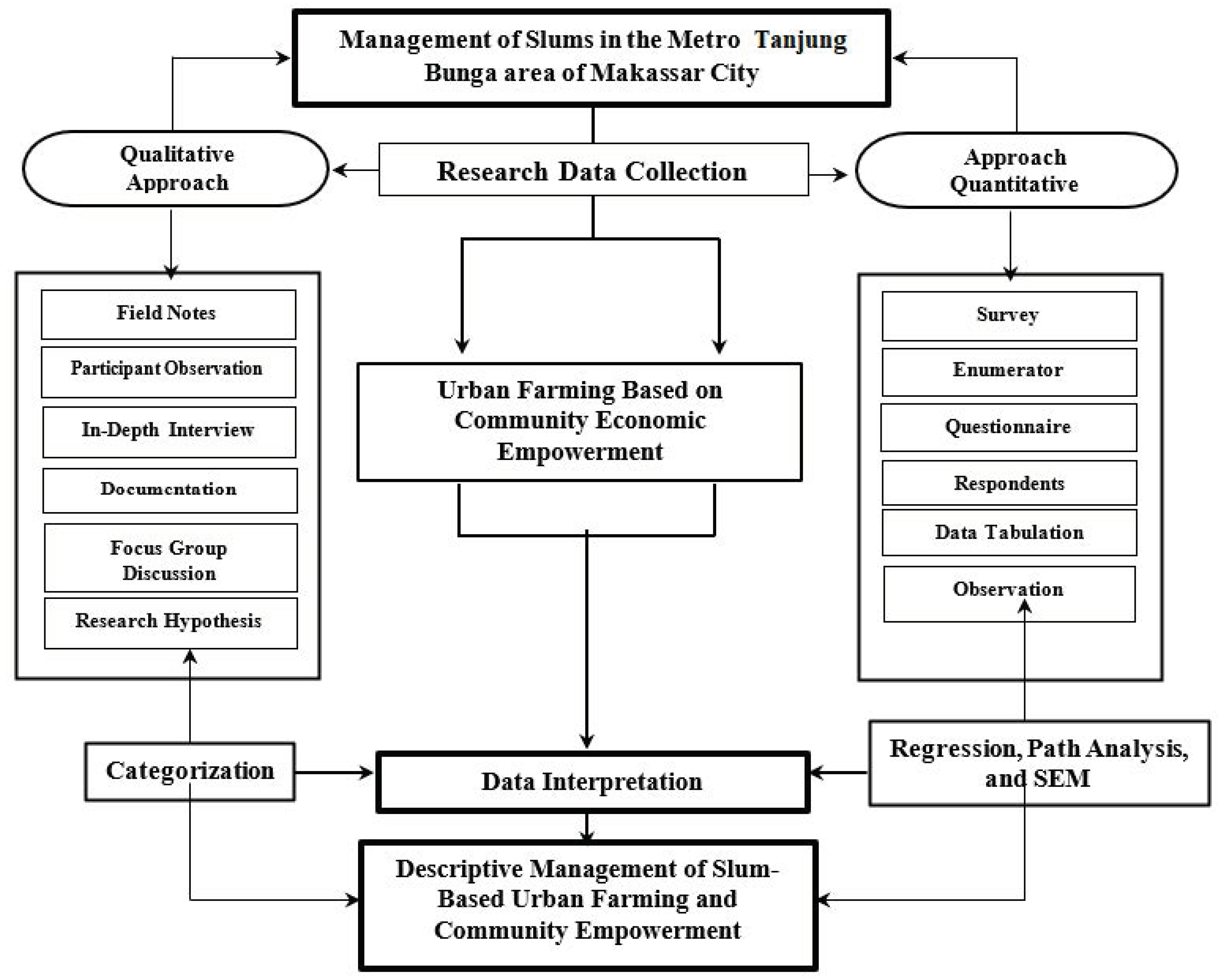
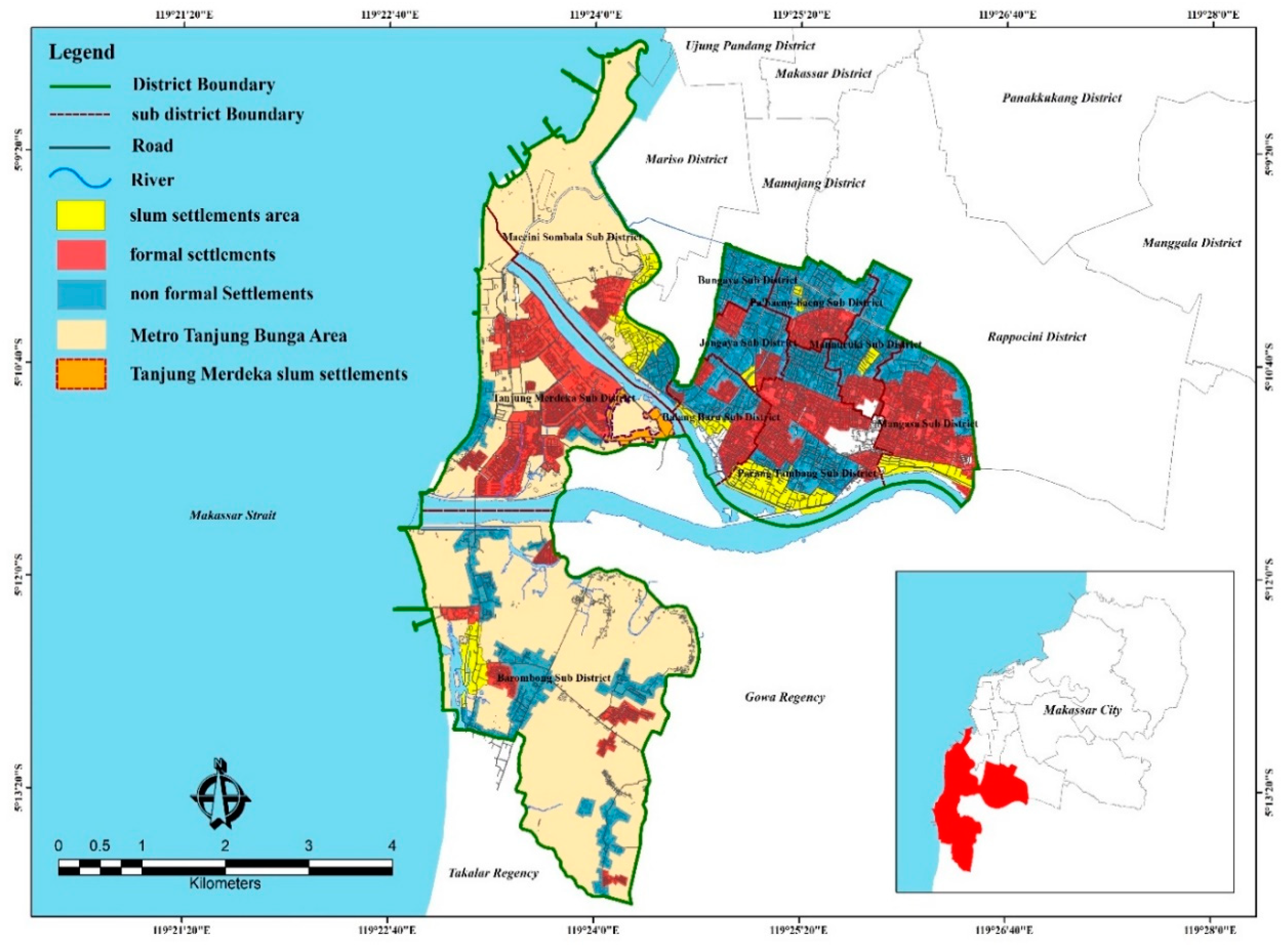

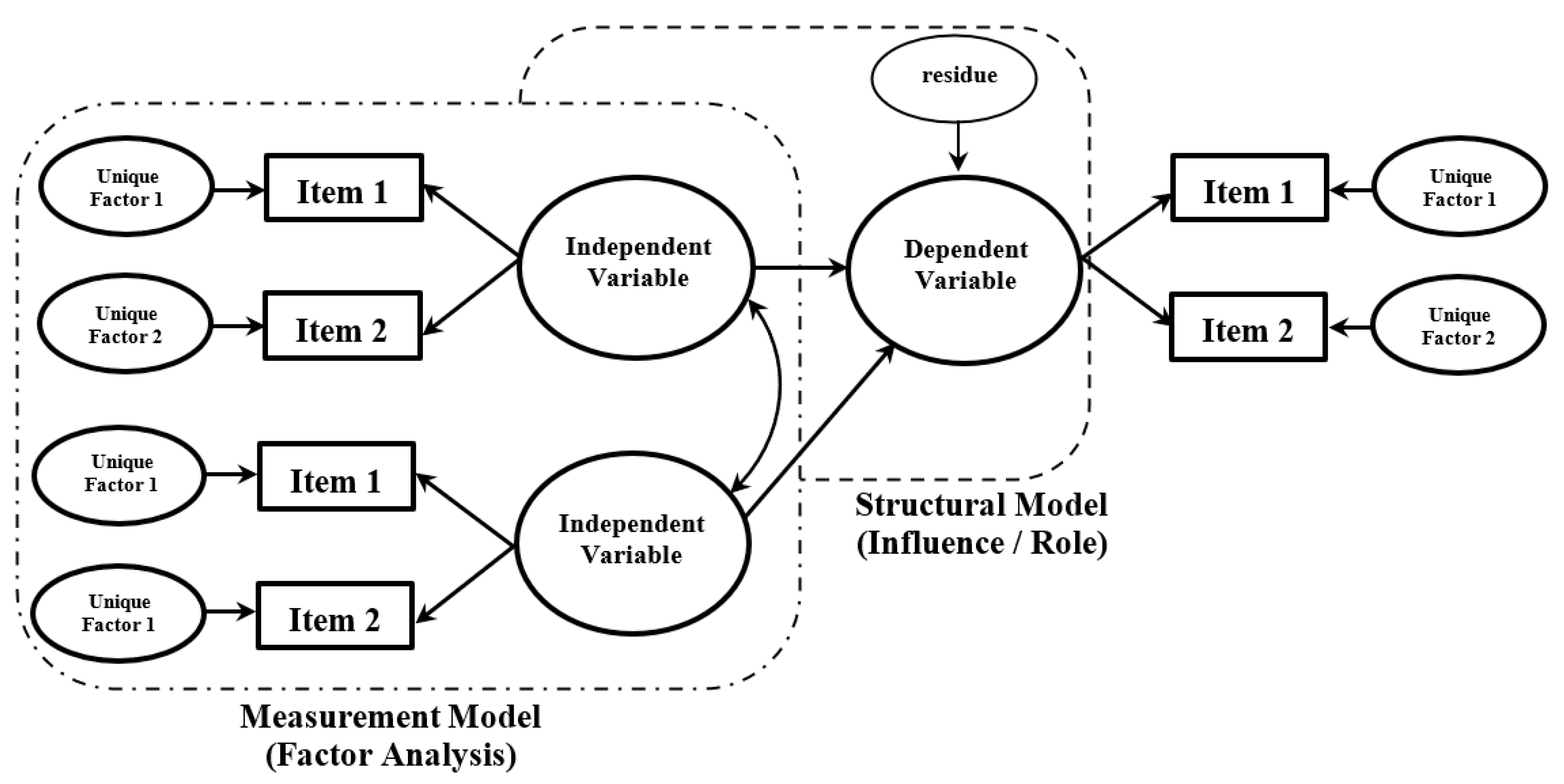
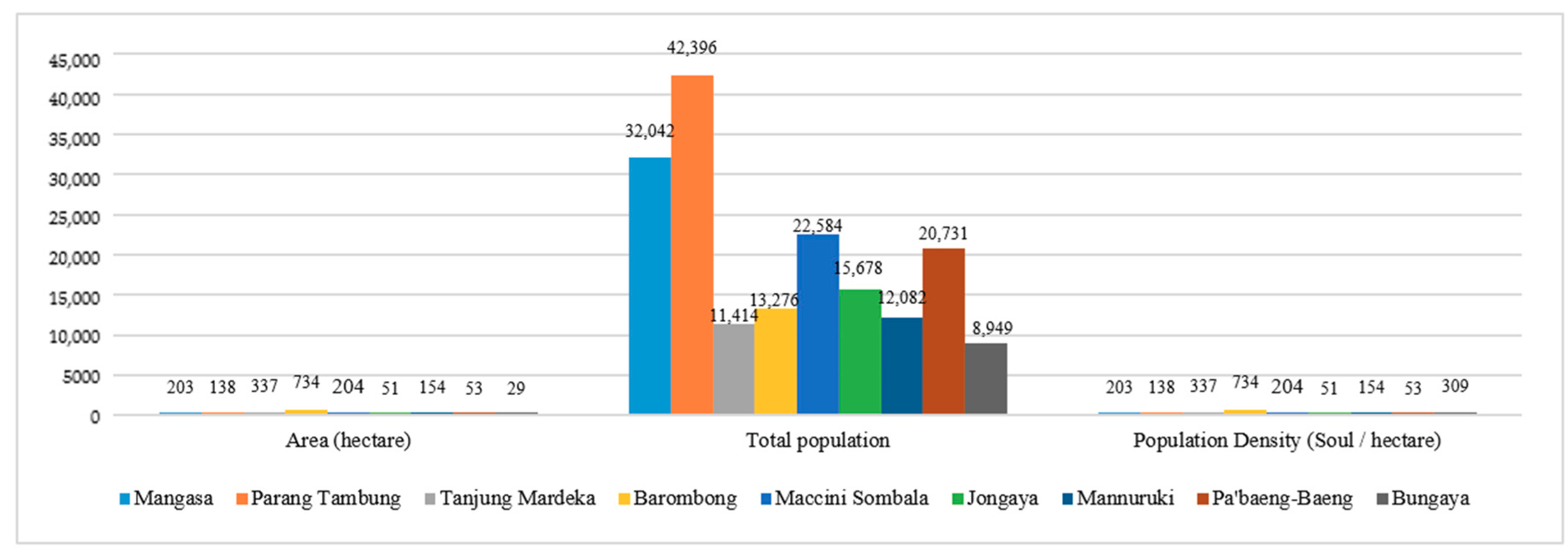
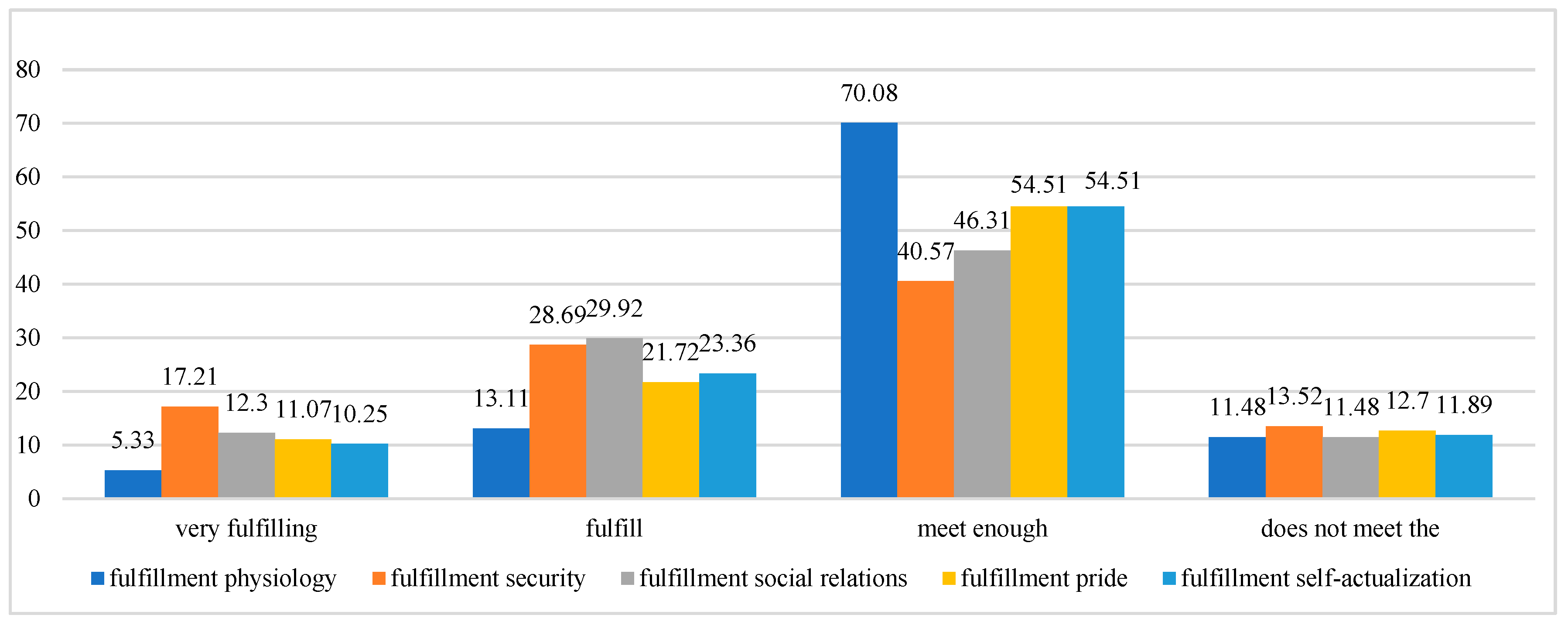
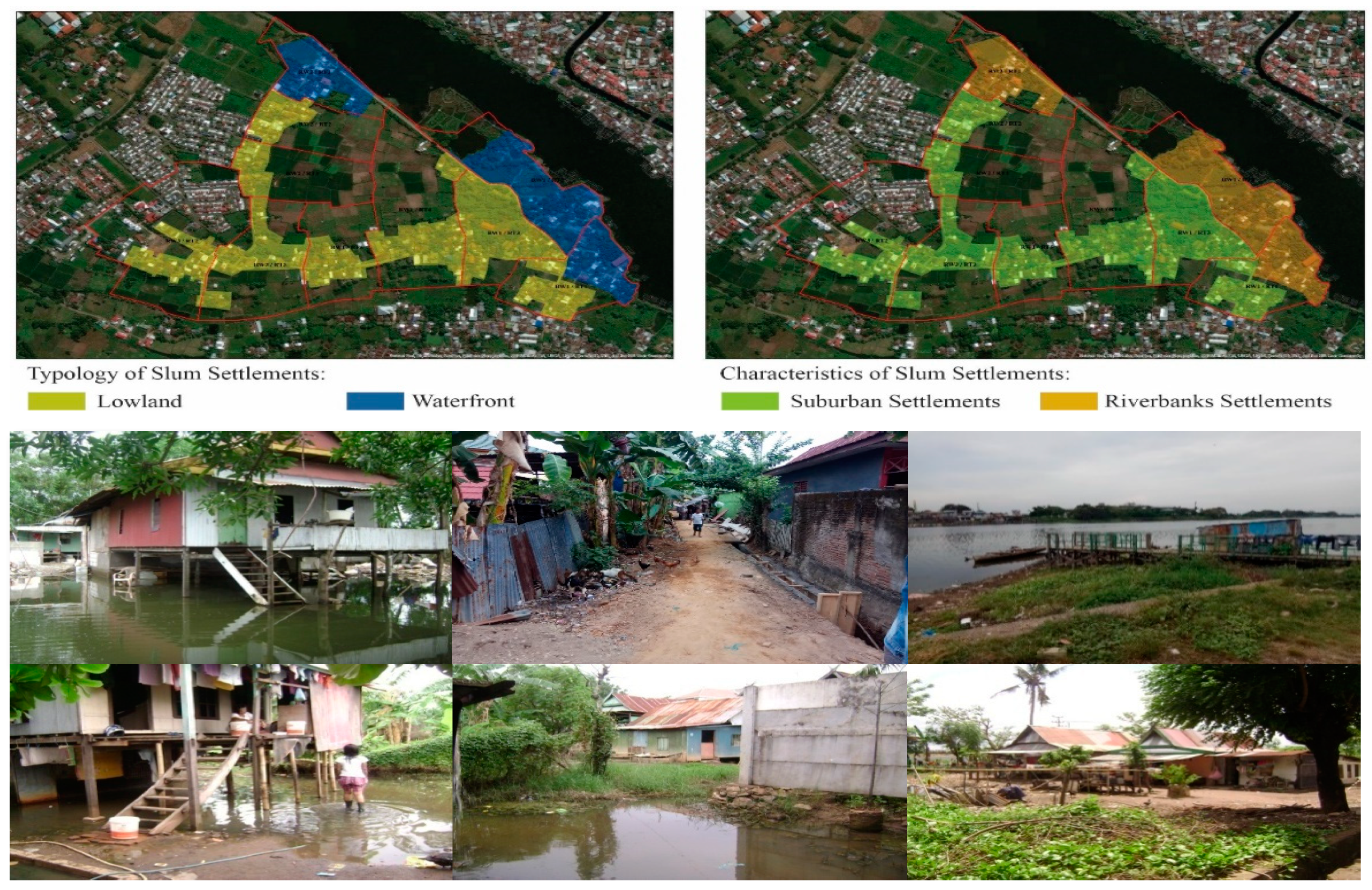
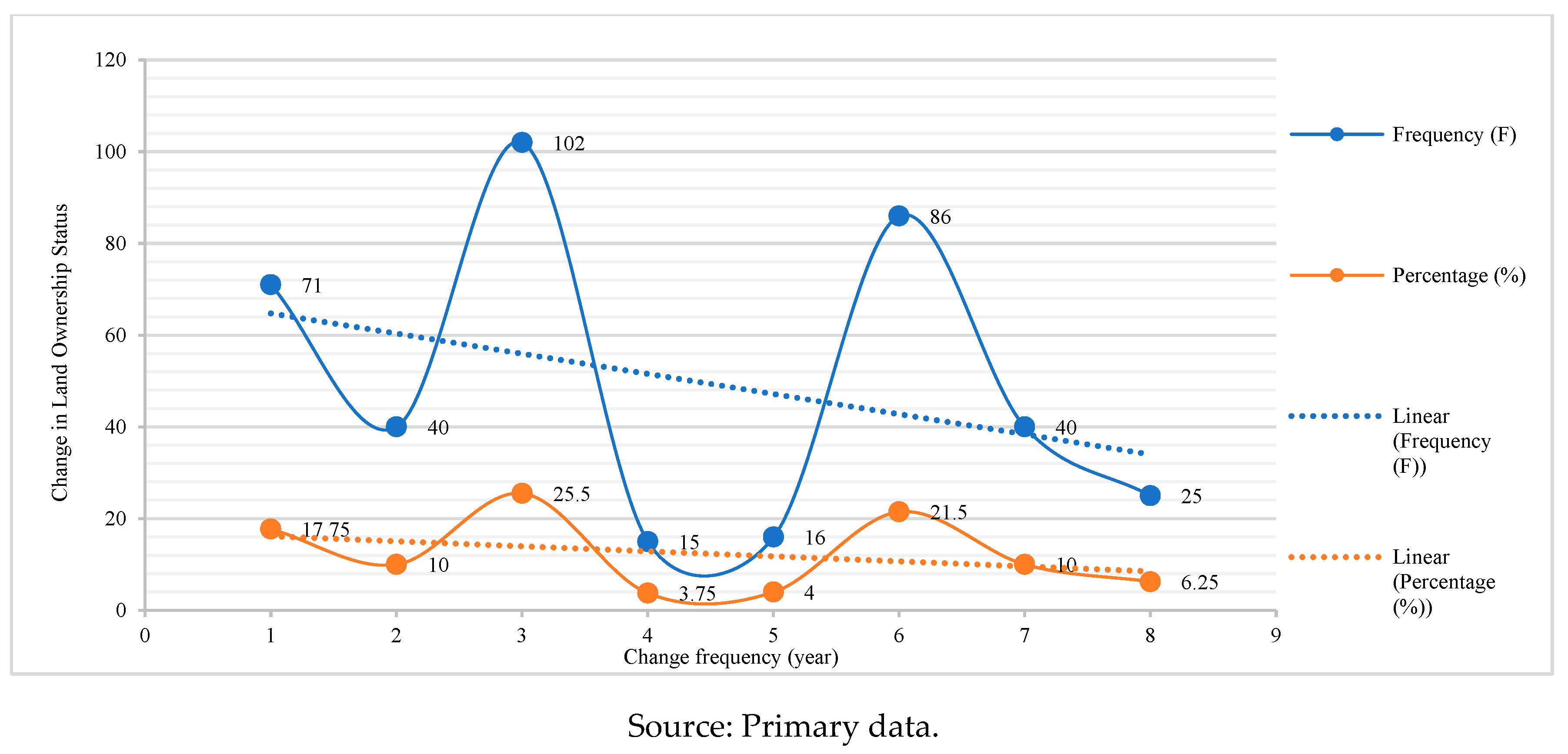
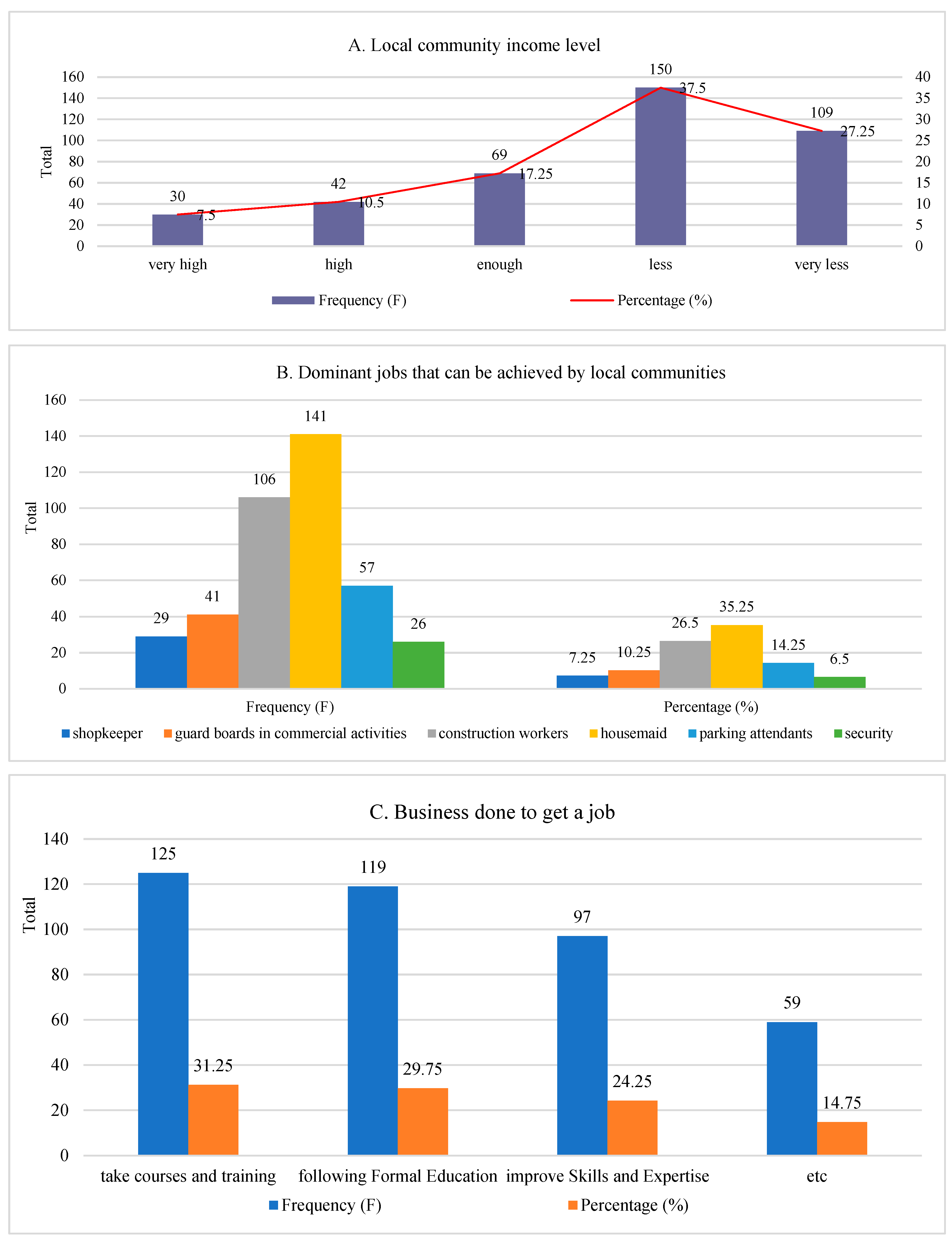

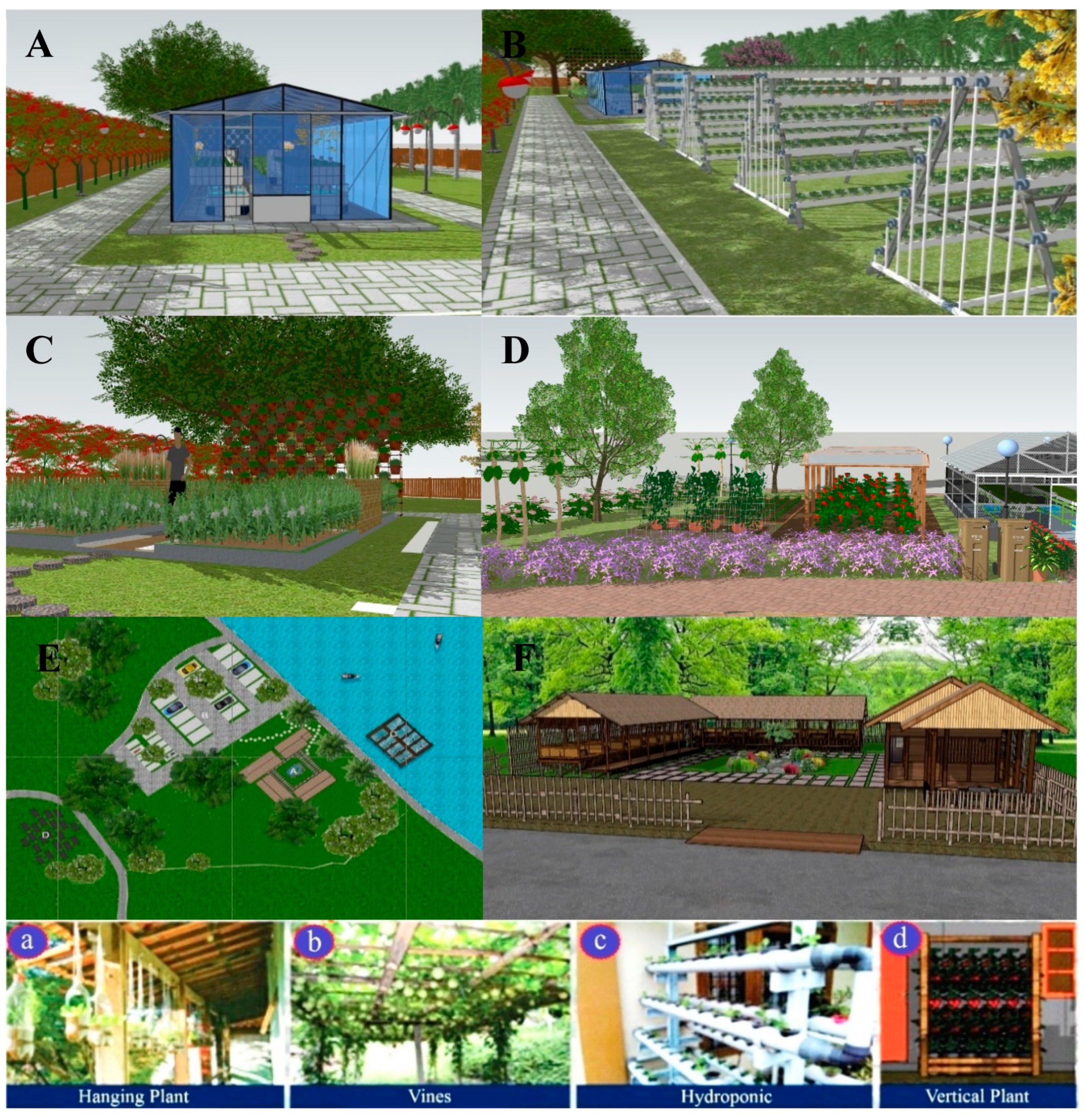
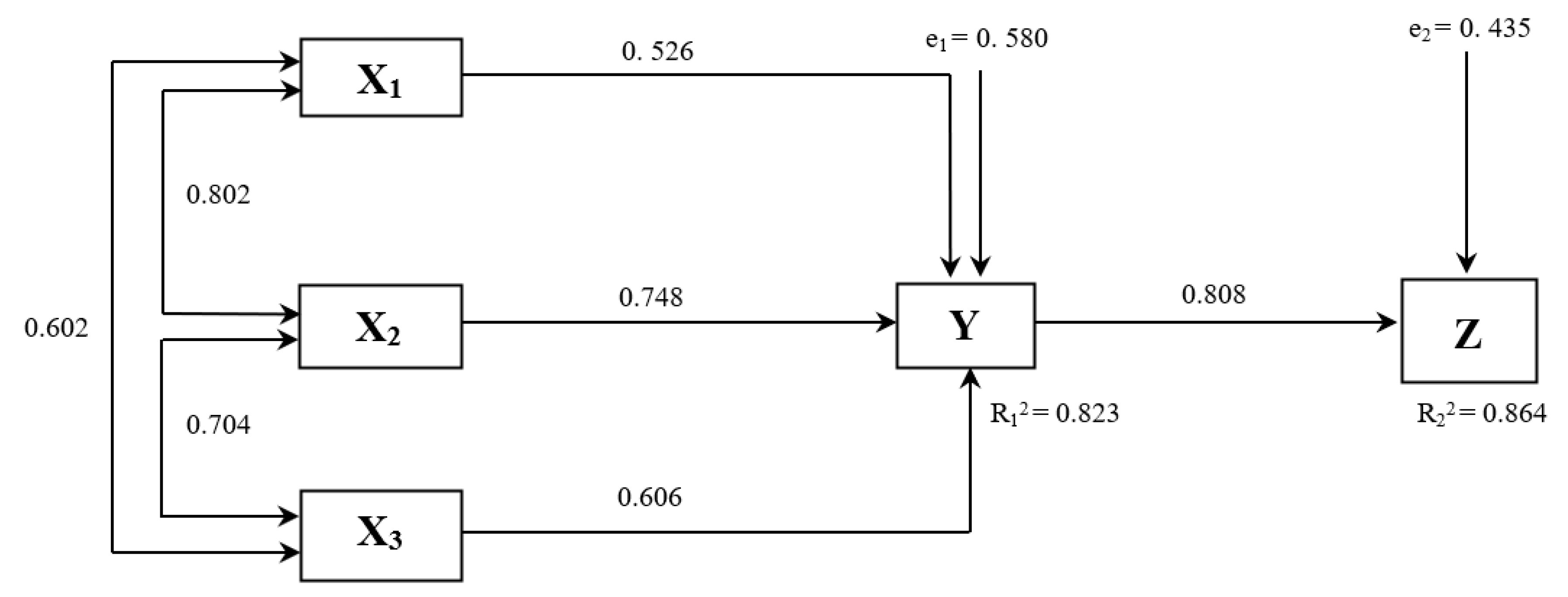
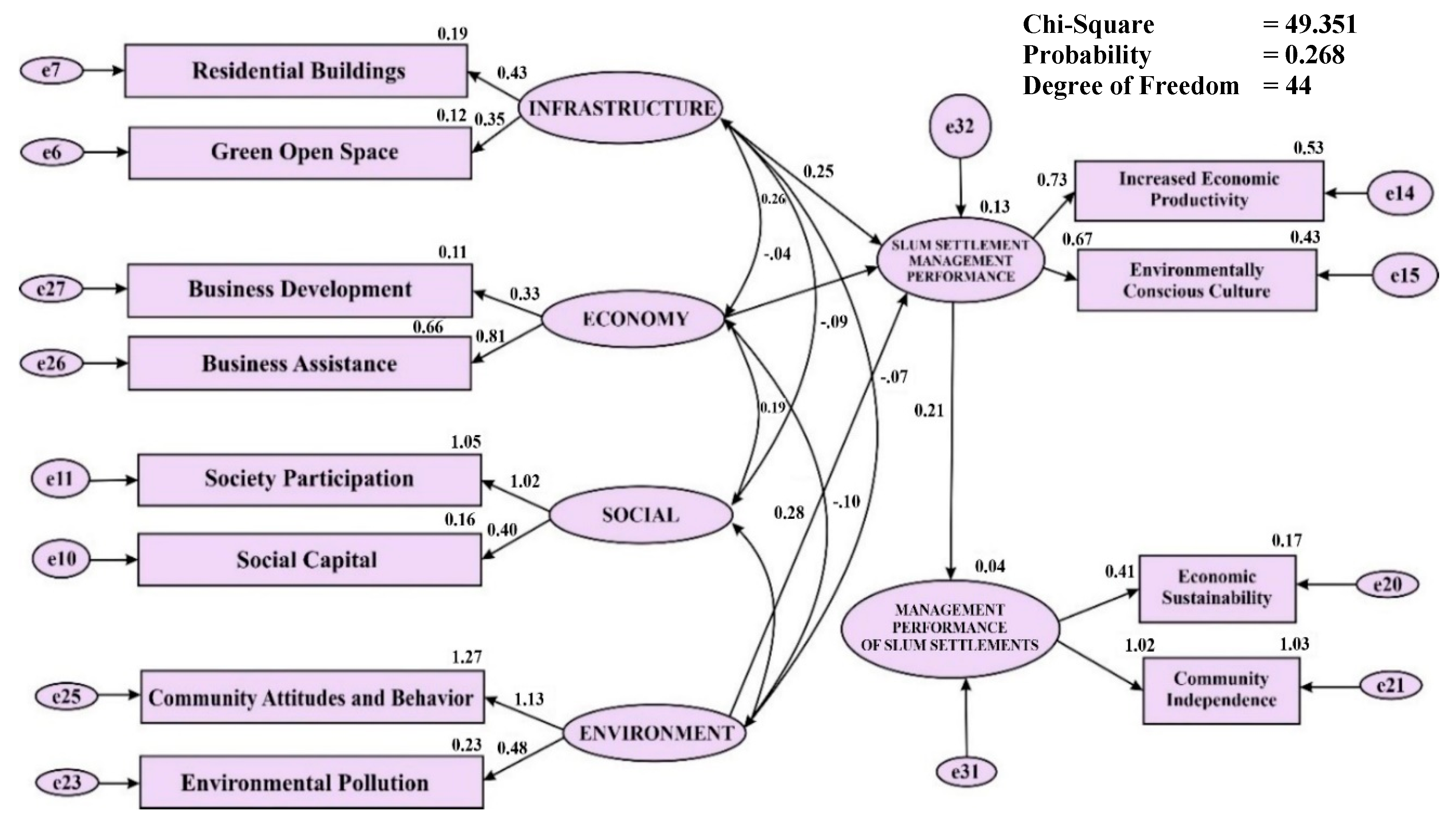
| Number | Village | Area (Hectares) | Head of Family | Total Population (Soul) |
|---|---|---|---|---|
| 1 | Mangasa | 203 | 10,348 | 32,042 |
| 2 | Parang Tambung | 138 | 9749 | 42,396 |
| 3 | Tanjung Mardeka | 337 | 2216 | 11,414 |
| 4 | Barombong | 734 | 3105 | 13,276 |
| 5 | Maccini Sombala | 204 | 5185 | 22,584 |
| 6 | Jongaya | 51 | 3932 | 15,678 |
| 7 | Mannuruki | 154 | 3583 | 12,082 |
| 8 | Pa’baeng-Baeng | 53 | 5059 | 20,731 |
| 9 | Balang Baru | 118 | 4018 | 19,058 |
| Number | Village | Slum Area (Hectares) | Geographical Position |
|---|---|---|---|
| 1 | Jongaya | 3.2 | 119°25′0.702″ E; 5°10′31.539″ S |
| 2 | Tanjung Merdeka | 17.19 | 119°23′36.434″ E; 5°10′52.923″ S |
| 3 | Balang Baru | 16.31 | 119°24′48.474″ E; 5°11′00.025″ S |
| 4 | Barombong | 30.53 | 119°23′44.642″ E; 5°12′38.569″ S |
| 5 | Maccini Sombala | 24.29 | 119°23′56.486″ E; 5°9′56.429″ S |
| 6 | Mangasa | 22.71 | 119°26′8.623″ E; 5°11′1.453″ S |
| 7 | Mannuruki | 4.16 | 119°25′46.280″ E; 5°10′31.847″ S |
| 8 | Pa’baeng-Baeng | 3.57 | 119°25′26.359” E; 5°10′16.355″ S |
| 9 | Parang Tambung | 42.84 | 119°25′22.031″ E; 5°11′11.164″ S |
| Number | Village | Population (Head of Family) | Sample (Head of Family) |
|---|---|---|---|
| 1 | Mangasa | 10,348 | 80 |
| 2 | Parang Tambung | 9749 | 70 |
| 3 | Tanjung Mardeka | 2216 | 20 |
| 4 | Barombong | 3105 | 30 |
| 5 | Maccini Sombala | 5185 | 45 |
| 6 | Jongaya | 3932 | 35 |
| 7 | Mannuruki | 3583 | 35 |
| 8 | Pa’baeng-Baeng | 5059 | 45 |
| 9 | Bungaya | 4018 | 40 |
| Total Samples | 400 | ||
| Correlated Variables | t Count | Sig. | Information | R2 |
|---|---|---|---|---|
| Business motivation leading to economic empowerment | 3.932 | 0.000 | Significant | 0.980 |
| Human resource capacity leading to economic empowerment | 3.848 | 0.000 | Significant | 0.980 |
| Community participation to economic empowerment | −3.962 | 0.000 | Significant | 0.973 |
| Business management to economic empowerment | 2.680 | 0.000 | Significant | 0.977 |
| Business motivation, human resource capacity, community participation, and business management leading to economic empowerment | 10.646 | 0.000 | Significant | 0.968 |
© 2020 by the authors. Licensee MDPI, Basel, Switzerland. This article is an open access article distributed under the terms and conditions of the Creative Commons Attribution (CC BY) license (http://creativecommons.org/licenses/by/4.0/).
Share and Cite
Surya, B.; Syafri, S.; Hadijah, H.; Baharuddin, B.; Fitriyah, A.T.; Sakti, H.H. Management of Slum-Based Urban Farming and Economic Empowerment of the Community of Makassar City, South Sulawesi, Indonesia. Sustainability 2020, 12, 7324. https://doi.org/10.3390/su12187324
Surya B, Syafri S, Hadijah H, Baharuddin B, Fitriyah AT, Sakti HH. Management of Slum-Based Urban Farming and Economic Empowerment of the Community of Makassar City, South Sulawesi, Indonesia. Sustainability. 2020; 12(18):7324. https://doi.org/10.3390/su12187324
Chicago/Turabian StyleSurya, Batara, Syafri Syafri, Hadijah Hadijah, Baharuddin Baharuddin, Andi Tenri Fitriyah, and Harry Hardian Sakti. 2020. "Management of Slum-Based Urban Farming and Economic Empowerment of the Community of Makassar City, South Sulawesi, Indonesia" Sustainability 12, no. 18: 7324. https://doi.org/10.3390/su12187324
APA StyleSurya, B., Syafri, S., Hadijah, H., Baharuddin, B., Fitriyah, A. T., & Sakti, H. H. (2020). Management of Slum-Based Urban Farming and Economic Empowerment of the Community of Makassar City, South Sulawesi, Indonesia. Sustainability, 12(18), 7324. https://doi.org/10.3390/su12187324





